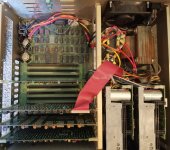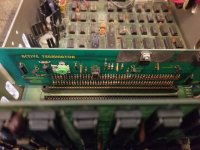Eudimorphodon
Veteran Member
It's been kind of a running joke for five years that I owned an S-100 computer that I'd never actually seen in person before. (A story primarily comprised of a long-distance adoption followed by several years of "how in the world am I going to safely ship this thing?") But now, thanks to some of the awkward circumstances our current world has imposed on traveling my Loch Ness Monster of a machine is now in my hands. And, man, I'm simultaneously excited and totally at a loss.
I haven't had any chance to clean it up so I'll save pictures of the outside, but a quick inventory of the inside:

Reveals four, or maybe three and a half, cards; there's a NorthStar Z80 CPU board, I think it's this one:
http://www.s100computers.com/Hardware Folder/Northstar/Z80CPU/Z80CPU.htm
A double-density Northstar controller:
http://www.s100computers.com/Hardware Folder/Northstar/MDS/MDS.htm
And a California Computer Systems 64k memory card, I think it's this one:
http://www.s100computers.com/Hardware Folder/CCS/2065 64K DRAM/2065 64K DRAM.htm
There's also a CompuPro Active Terminator plugged in:

Besides the computer itself I have one copy-paper size box of manuals, a few disks, and two spare memory cards, a 16k static board that is similar but not identical to this one:
http://www.s100computers.com/Hardware Folder/CCS/16K RAM/16K RAM.htm
(It says (c)1978 JTM on the back, the positions of the switches and some other components differs slightly from the California Computer Systems board)
And a 16k Northstar dynamic board like this one (but with the parity sockets populated... but empty):
http://www.s100computers.com/Hardware Folder/Northstar/16K Dynamic RAM/16K DRAM.htm
(and for some reason the leads have been clipped on the lower voltage regulator so... broken?) I assume the 16k board is what came with the machine? Judging from some of the penciled notes in the manuals I think the machine may have been assembled from a kit instead of purchased fully built.
Anyway... I'm currently at sort of a loss how to approach resurrecting this sleeping giant. The power supply is the S-100 Linear stereotype with a transformer the size of a softball and a couple coke-can capacitors:

I don't have a variable transformer available to try to slowly "preheat" it like I've seen suggested sometimes, but at the very least are there some preflight checks I can do with standard tools (IE, multimeter) to determine if it's likely to just go nuclear when plugged in? (And, also, would it be better to pull all the cards and disk power plugs for the initial power-up? Unfortunately the Northstar has active components on the motherboard, IE, serial and parallel circuitry, so I can't easily just reduce it to a bare backplane. There's kind of an intimidating spider's web of wires between those capacitors and their tie-downs on the motherboard that I haven't wrapped my head around yet.)
The next step after that is, well, I'm deeply concerned about the state of both the floppy drives and the disks I have. The disks are *really* dusty, some of them look scratched, and at least some others the plastic of the jackets is coming apart. I've tried to do some research on what the state of things is, but does anyone know if there's at this point a working solution for using a floppy emulator with the Northstar hard sector format?
According to my research so far the Horizon didn't have a boot monitor ROM by default, the CPU board just blindly jumps to the 256 byte PROM on the disk controller? I assume that PROM doesn't send anything out the serial console, so unless I by some miracle have a working CP/M boot disk and can get a drive to work I'll be flying blind from a console perspective?
... and speaking of drives, I'm sure at the very least the original drives will need belts and a lot of TLC. If a floppy emulator isn't an option, is it possible to use a later slimline 5 1/4" drive with the Northstar controller to read the original disks? (I have available the stock drive from a Tandy 1000 EX, which used standard Shugart jumpering, and I think I also have a similar vintage drive pulled from a PC clone kicking around that's old enough to be jumpered conventionally.)
I haven't had any chance to clean it up so I'll save pictures of the outside, but a quick inventory of the inside:

Reveals four, or maybe three and a half, cards; there's a NorthStar Z80 CPU board, I think it's this one:
http://www.s100computers.com/Hardware Folder/Northstar/Z80CPU/Z80CPU.htm
A double-density Northstar controller:
http://www.s100computers.com/Hardware Folder/Northstar/MDS/MDS.htm
And a California Computer Systems 64k memory card, I think it's this one:
http://www.s100computers.com/Hardware Folder/CCS/2065 64K DRAM/2065 64K DRAM.htm
There's also a CompuPro Active Terminator plugged in:

Besides the computer itself I have one copy-paper size box of manuals, a few disks, and two spare memory cards, a 16k static board that is similar but not identical to this one:
http://www.s100computers.com/Hardware Folder/CCS/16K RAM/16K RAM.htm
(It says (c)1978 JTM on the back, the positions of the switches and some other components differs slightly from the California Computer Systems board)
And a 16k Northstar dynamic board like this one (but with the parity sockets populated... but empty):
http://www.s100computers.com/Hardware Folder/Northstar/16K Dynamic RAM/16K DRAM.htm
(and for some reason the leads have been clipped on the lower voltage regulator so... broken?) I assume the 16k board is what came with the machine? Judging from some of the penciled notes in the manuals I think the machine may have been assembled from a kit instead of purchased fully built.
Anyway... I'm currently at sort of a loss how to approach resurrecting this sleeping giant. The power supply is the S-100 Linear stereotype with a transformer the size of a softball and a couple coke-can capacitors:

I don't have a variable transformer available to try to slowly "preheat" it like I've seen suggested sometimes, but at the very least are there some preflight checks I can do with standard tools (IE, multimeter) to determine if it's likely to just go nuclear when plugged in? (And, also, would it be better to pull all the cards and disk power plugs for the initial power-up? Unfortunately the Northstar has active components on the motherboard, IE, serial and parallel circuitry, so I can't easily just reduce it to a bare backplane. There's kind of an intimidating spider's web of wires between those capacitors and their tie-downs on the motherboard that I haven't wrapped my head around yet.)
The next step after that is, well, I'm deeply concerned about the state of both the floppy drives and the disks I have. The disks are *really* dusty, some of them look scratched, and at least some others the plastic of the jackets is coming apart. I've tried to do some research on what the state of things is, but does anyone know if there's at this point a working solution for using a floppy emulator with the Northstar hard sector format?
According to my research so far the Horizon didn't have a boot monitor ROM by default, the CPU board just blindly jumps to the 256 byte PROM on the disk controller? I assume that PROM doesn't send anything out the serial console, so unless I by some miracle have a working CP/M boot disk and can get a drive to work I'll be flying blind from a console perspective?
... and speaking of drives, I'm sure at the very least the original drives will need belts and a lot of TLC. If a floppy emulator isn't an option, is it possible to use a later slimline 5 1/4" drive with the Northstar controller to read the original disks? (I have available the stock drive from a Tandy 1000 EX, which used standard Shugart jumpering, and I think I also have a similar vintage drive pulled from a PC clone kicking around that's old enough to be jumpered conventionally.)
